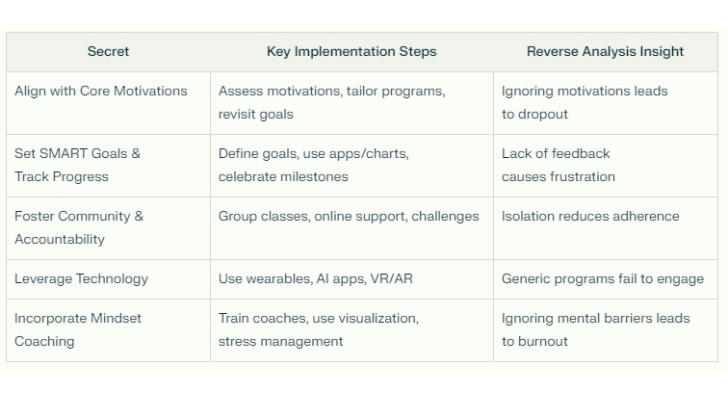Secrets of a Fitness Coach: The Secret to Keeping Trainees Motivated
Motivation is the fuel that powers every fitness journey. For fitness coaches, maintaining that motivation in trainees is both a science and an art. In 2025, with the fitness industry projected to reach a staggering $348.7 billion globally, understanding how to keep trainees engaged and inspired is more important than ever. The secret to sustained motivation lies in blending data-driven strategies, psychological insight, and practical implementation.
This article presents the key tips that fitness trainers use to keep their students motivated. It also provides detailed guidance on how to effectively implement these strategies, backed by the latest trends and reverse analysis of common motivation traps, as well as real-life examples that illustrate how these principles keep students engaged, engaged, and thriving.
Understanding Motivation: What the Data Tells Us
Recent research and industry reports highlight several core motivators for fitness participation in 2025:
Health and Wellness: 78% of exercisers cite improving physical health as their primary motivation.
Mental Health Benefits: 38% exercise to improve mental well-being, with younger generations and higher earners emphasizing this more strongly.
Visible Progress: 38% are motivated by measurable improvements in strength, endurance, or body composition.
Social Connection: Group classes and community support increase adherence by over 200%.
Technology Engagement: Wearable tech and AI-driven apps provide personalized feedback and motivation, enhancing commitment.

Understanding these drivers enables coaches to tailor their approach to meet trainees’ unique needs.
Secret #1: Align Training with Core Motivations
Implementation Steps:
Conduct an initial assessment to identify each trainee’s primary motivation (e.g., health, mental wellness, progress).
Design programs that emphasize these motivators: mindfulness and stress relief for mental health-focused clients; functional training and injury prevention for health-driven clients; progressive overload and tracking for progress-oriented trainees.
Regularly revisit and adjust goals to keep them relevant.
Reverse Analysis: When training programs ignore personal motivations, trainees often lose interest and drop out. Coaches who fail to align workouts with what truly matters to their clients see lower retention rates.
Secret #2: Set SMART Goals and Track Progress Visibly
Data shows that clear, measurable goals and visible progress tracking significantly boost motivation. Trainees who see tangible results are more likely to stay committed.

Implementation Steps:
Help trainees set SMART goals (Specific, Measurable, Achievable, Relevant, Time-bound).
Use apps, charts, or photos to track progress and share updates regularly.
Celebrate milestones, no matter how small, to reinforce positive behavior.
Reverse Analysis: Lack of feedback or unclear goals leads to frustration and demotivation. Coaches who neglect progress tracking risk trainees feeling their efforts are futile.
Secret #3: Foster Community and Social Accountability
Although 61% of people work out solo, social connection remains a powerful motivator, increasing adherence by over 200%. Coaches who cultivate community create accountability and encouragement.
Implementation Steps:
Offer group classes or partner workouts to build camaraderie.
Create online communities or social media groups for trainees to share progress and support.
Encourage friendly challenges or fitness competitions.
Reverse Analysis: Isolation and lack of social support contribute to dropout. Trainees who feel disconnected lack accountability and motivation.
Secret #4: Leverage Technology for Personalized Motivation
Wearable technology, AI-driven apps, and virtual coaching platforms are top fitness trends in 2025. These tools provide personalized data and timely prompts that keep trainees engaged.
Implementation Steps:
Integrate wearable devices to monitor heart rate, steps, and sleep.
Use AI-powered coaching platforms to customize workouts and send motivational reminders.
Incorporate virtual or augmented reality experiences to make workouts immersive and enjoyable.
Reverse Analysis: Generic, one-size-fits-all programs fail to engage trainees accustomed to personalized digital experiences. Coaches who ignore technology risk losing relevance.
Secret #5: Incorporate Mindset Coaching to Overcome Mental Barriers
Mental health is a growing fitness motivator, but stress, self-doubt, and time constraints often derail motivation. Mindset coaching helps trainees develop resilience and a positive outlook.
Implementation Steps:
Train coaches in mindset and cognitive behavioral techniques.
Use visualization, goal reframing, and stress management exercises in sessions.
Provide educational content on the mental health benefits of exercise.
Reverse Analysis: Ignoring mental barriers leads to burnout and dropout. Coaches who fail to address mindset miss a critical component of sustained motivation.

Case Studies: Motivation Secrets in Action
Case Study 1: Emily - Harnessing Mental Health Motivation
Emily, 23, struggled with anxiety and found solo workouts uninspiring. Her coach emphasized mental health benefits by integrating yoga, meditation, and group classes. Wearable tech tracked her mood and activity, showing a clear link between exercise and reduced anxiety. Small, achievable goals and frequent celebrations kept her motivated.
Outcome: Emily increased her workout frequency from twice to five times weekly and reported significant mental well-being improvements.
Case Study 2: Robert - Focus on Health and Visible Progress
Robert, 62, wanted to improve cardiovascular health and mobility. His coach designed a low-impact cardio and strength program aligned with his wellness goals. Regular fitness assessments and wearable monitors tracked progress, while nutritional education supported recovery.
Outcome: Robert’s health markers improved, and visible progress kept him motivated despite initial skepticism.
Case Study 3: Sarah - Progress and Community-Driven Motivation
Sarah, 29, thrived on measurable progress and social connection. Her coach used AI-powered apps for personalized workouts and instant feedback. Group strength training classes provided community support and accountability.
Outcome: Sarah hit multiple personal records and maintained a consistent workout schedule, crediting personalized coaching and social engagement.
Summary: Implementing the Secrets

Conclusion
The secret to keeping trainees motivated lies in a holistic, data-driven approach that addresses physical, mental, and social dimensions. By aligning workouts with personal motivations, setting clear goals, fostering community, leveraging technology, and supporting mindset, fitness coaches can ignite and sustain the inner fire that drives lasting fitness success.
In the rapidly evolving fitness landscape of 2025, coaches who embrace these strategies will not only improve client retention and outcomes but also empower trainees to transform their lives.
